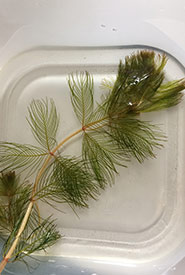
Eurasian milfoil (Photo by Danielle St. Louis)
Eurasian milfoil
What does it look like?
An invasive aquatic plant, Eurasian milfoil is a weed that grows quickly. Known also as the “zombie plant,” this perennial (plants that live for more than two years) has soft feather-like green leaves that circle around the stem in groups of four or five. Its stems are long, branched, vine-like and range from reddish-brown to whitish-pink in colour. Unlike native northern milfoil, which has leaves with 11 or fewer leaf segments, Eurasian milfoil leaves have 12 or more.
Where does it grow?
Eurasian milfoil is an invasive weed found in six provinces across Canada: British Columbia, Manitoba, Ontario, Quebec, New Brunswick and Prince Edward Island.
While the plant usually grows in shallow waters, it can take root in up to 10 metres of water. The species often establishes itself in slow or still bodies of water with a sand or silt bottom.
How has this invasive species impacted habitats and other species?
Eurasian milfoil aggressively out-competes native plant species, such as native milfoil. This reduces biodiversity and water quality. The plant grows quickly and forms a thick mass of tangled stems underwater and mats of vegetation on the surface of water bodies. Dense mats of Eurasian milfoil on the water’s surface block light from penetrating the water, which shades out native aquatic vegetation. Stands of the plant results in stagnant water and can create ideal breeding grounds for mosquitoes.
Fish populations are also negatively impacted. Fish can’t swim through dense mats of Eurasian milfoil, and when the plants begin to rot it can reduce oxygen levels. The plant also poses a problem to human recreational activities, such as swimming, fishing and boating. Stems of the weed often get entangled in rudders and boat propellers.
How can you help reduce the spread of this species?
To avoid the spread of Eurasian milfoil, people should take precautions. Learn to identify the species, and avoid infested areas. Boaters should inspect their boat and equipment after every use for the invasive species and reduce their speed with waters infested with the plant. The aquatic plant is easily fragmented. Propellers can break off fragments and spread the species, beginning a colony in a new area from just a small piece of the plant. Boats that are moved between water bodies should always be cleaned, drained and dried to help stop the spread of this, and other, invasive aquatic species.
Report sightings of Eurasian milfoil to provincial invasive species councils or through apps, such as iNaturalist. Helping track the spread of invasive species guides scientists and land managers in their methods to control them.




